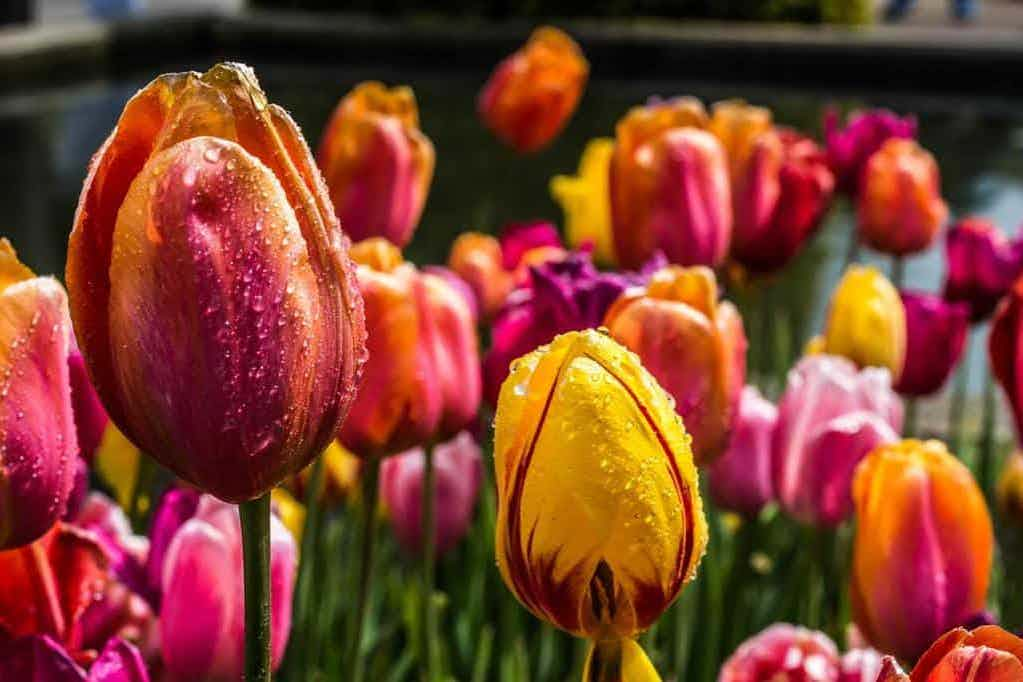One of the signs that spring has arrived is the beautiful burst of colour that tulips bring to the garden. When these distinctive leaves start to poke above the surface, it’s a sure sign that warmer weather is on its way. It is a welcome sight after a long, cold winter.
Planning can help ensure your garden looks it’s best in early springtime, especially when it comes to planting tulips. The best time to plant these plants is in late autumn and during wintertime. This is when the tulip bulbs start to grow and root into the ground.
Are tulips easy to grow?
Tulip bulbs are hardy and can withstand the winter cold. Once you have them planted in the right place, they are easy to maintain. In fact, winter is when they fare best in the ground. They use the cold months to cultivate and grow so that when the earliest signs of spring appear, they are ready to burst into full bloom.
When it comes to planting bulbs, most of the work is in the preparation and planning before planting. Once the bulbs are in the ground, you can relax and wait for spring.
Let’s look at how you plant and grow tulips.
How to grow tulips
You can buy tulip bulbs anytime during autumn. Still, you should wait to plant them until at least late October or early November. During this time, you need to ensure that you are storing the bulbs correctly.
How to store bulbs before planting
Tulip bulbs need a period of cold storage before planting. Any bulbs you have rescued from the garden earlier in the year need moving to a suitable storage area. The best place to store tulip bulbs during the weeks before planting is in the fridge. More specifically, in the salad drawer. Pop them into a clear bag and leave the bag open at the top then put the bulbs into the fridge. You need to ensure to keep the bulbs away from other fruit and veg as these can release gases that kill the bud inside the bulb. Don’t try and store the bulbs in the freezer; this will kill the bulb!
Not everyone has the space to put bulbs in the fridge, so a good alternative is to keep them in a well ventilated and cool place. An unheated garage or even your garden shed should suffice. Pop them into a net bag or tray and put them into a corner where nothing will disturb them.
Where to plant tulips
For best results plant your tulip bulbs in a sunny spot with well-drained soil. Your first step is to check the areas of your garden where the tulips will be happiest. The best soil you can use is a crumbly soil that drains well. The most important aspect of the soil to consider is how well it drains. Tulip bulbs that are sitting in too much moisture can rot in the ground. If you have soil with a heavy clay element, then make sure you dig down well enough and add a grit or sand mixture to the earth to avoid too much moisture clogging up the ground around the bulbs.
You can also plant your tulips in pots. If this is your best option, place the pots a warm and sunny spot in the garden.
When to plant tulip bulbs
Planting tulips at the right time is a critical step in ensuring beautiful blooms in spring. Tulips grow best when planted during colder months and won’t start to root until the ground is cold. This is because the cold helps to kill any fungus that can cause damage or disease to the bulbs.
The best time to plant bulbs is in late October through to early December. This ensures that the bulbs have plenty of time in the cooler months to put down roots and grow. Any earlier than this and you run the risk of killing your bulbs.
How to plant tulip bulbs
- Before you start, sort through your tulip bulbs. You want only to plant the best quality bulbs, so throw out any that look damaged or diseased. You should be able to tell quickly just by looking at, feeling and smelling the bulbs. If any are soft or mushy, have dark spots or smell’s musty or mouldy, then throw them out. It isn’t worth risking disease to all of your bulbs for the sake of a few damaged or diseased bulbs.
- Grab yourself a trowel and take the bulbs to your chosen planting location.
- Dig a hole for each bulb. You need to dig the hole to a depth of two to three times the height of the bulb. This should be at least 8 inches deep.
- Try and ensure that you dig each hole about 8 inches apart. This helps to ensure there is enough space for each plant to grow.
- You also need to dig the hole to be double the width of the bulb.
- Pop in about two inches of sharp sand or gardening grit into the bottom of the hole. This is to help with drainage. You can also add in some bonemeal to help fertilise the plant.
- Place the bulb in the hole with the pointed end facing upwards. This is the end the stalk and leaves will grow.
- Cover the bulb with soil.
- Place a thin layer of mulch over the top to protect the bulb and water.
Cultivating and growing tulips
Once you have planted your tulip bulbs, you have completed most of the hard work! You might need to keep an eye out for signs of hungry pests digging up the bulbs through winter. Deter these by putting down some gravel or thorny foliage over the soil.
Make sure you keep an eye on the weather. You don’t want to overwater the tulips, so it is unlikely that you need to water them often. However, up until the ground freezes if the weather is particularly dry, then you can water lightly about once a week.
When the tulips start to emerge from the soil, you can add some nutrients to the ground to prove some extra nourishment.
Can I plant tulips in the spring?
Whilst you can plant tulip bulbs a little later in the season, you can find there are problems when the weather is warmer. The bulbs need the cold ground to grow and put down roots. Things might look dormant and bare in your garden during wintertime, but just beneath the surface, your plants are busy preparing for the spring and summer.
If you do want to try and plant bulbs in spring, you might find the warm, damp soil causes disease to the bulbs. If they do survive, you might find they don’t flower this year, and you may have to wait till the following season for your floral display.
Can you leave tulip bulbs in the ground all year?
The answer to this question is technically yes, but that doesn’t mean you should. Tulips are perennial, which means they can grow and flower back, year after year. However, much can go wrong with the bulb when it is in the ground. Warm, wet soil is not suitable for tulip bulbs and can cause fungus, disease, and rotting. In general, it’s best to dig up your bulbs and store them until it’s time to plant again.
You need to wait until the flower has died off and the stalk has started to die and turn yellowy before digging up the bulb. This could take up to six weeks.
Once the plant has died off, you can lift the bulb carefully from the ground and brush off any loose dirt. It is worth taking the time now to sort through and discard any that show signs of damage. These can be any bulbs that smell a little mouldy, are soft to touch or have obvious signs of disease. When you have the bulbs, you want to keep for the next season then store them in a tray, without a lid or in net bags for ventilation. Pop the trays or bags in a warm and dark place until autumn time.
Growing and cultivating tulips
We spoke to Meg Edmonds from Flowers from the Farm, who told Age Times: "Tulips planted in the winter offer a myriad of colour in the late spring garden. And it's not all about the colour - remember when browsing those catalogues to look out for tulips with different shape and texture.
"Some of my favourites are the wonderful 'parrots', fringed large heads that open to show the most extraordinary texture and of course the doubles that are so elegant. One of the latest large cup varieties, 'Menton' is always popular for its deep pinky, peach colour, and a bulb that comes back year after year.
"Most of all a tulip in the vase often lasts for as long as two weeks making it a really popular cut flower, heralding the beginning of the British flower season."
To sum up, tulips are an easy plant to grow and cultivate as long as you have some nice sunny spots to plant them in the garden! These stunning blooms love well-drained soil and the sun so if you need to add some drainage when you plant then adding some horticultural grit or sand to the bottom of the hole before you place the bulb should work. To get the best results, plant your tulips in late autumn or winter. This is when tulips do most of their growing underground. Once you have planted the bulbs, all you have left to do is sit back and wait till spring arrives in all its glory.








